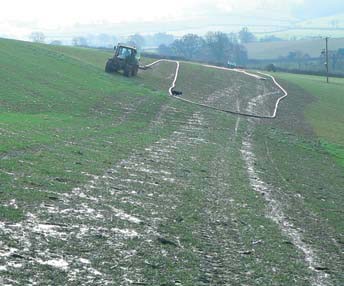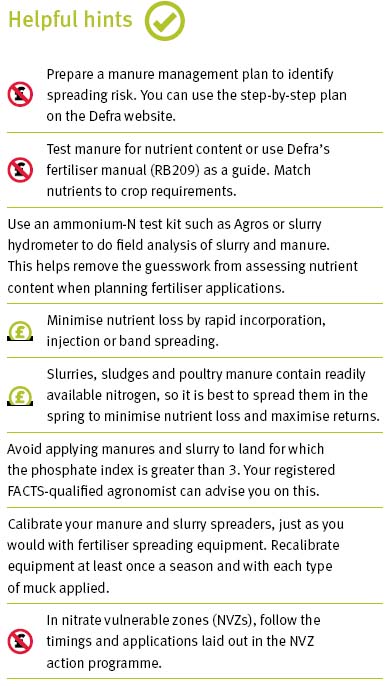40% saved on fertiliser costs by using nutrients from slurry

In association with the Environment Agency
Elwyn Jones is an agricultural contractor in North Wales who specialises in slurry spreading. He uses a calibrated tanker with injectors to deliver slurry accurately to the roots of the grass.
The main benefits of this method are that grass can be grazed sooner and there is no contamination when silage is cut. Some of Mr Jones’ farmer customers calculate that they have saved as much as 40% in fertiliser costs. This saving will increase as energy and fertiliser prices rise.
Slurry should be analysed before spreading to establish the quantities of nutrients it will provide to the growing crop and to reap the greatest benefits.
“Slurry is an important alternative to large quantities of bagged fertiliser,” Mr Jones says. “It can save farmers a lot of money when applied at the right time and in the right place.”
Counting the cost and reaping the benefits
• Farmers can save more than 40% in fertiliser costs by taking nutrients from slurry into account
• The typical nutrient content of 30m3 of cow slurry containing 6% dry matter is 90kg of nitrogen, 36kg of phosphate and 105kg of potassium oxide. This can be worth more than £200/ha over two seasons
Nutrient and manure management planning
Regular soil analysis and a nutrient management plan can help you make the most of all your inputs, says Paul Meakin of the Environment Agency. They can also help minimise nutrient losses through runoff or leaching into watercourses and groundwater.
Good planning will enable you to ensure that applications are timely and appropriate and that organic matter is used effectively to maintain soil fertility, he says.
“Take into account nutrients from autumn applications that will not be available to crops in the following spring. You may find it helpful to use Tried and Tested – the industry’s new nutrient management planning tool.”
Helpful hints:
• Prepare a nutrient management plan to make the most of your inputs. Use fertiliser efficiently by basing applications on soil analysis and crop need
• Use computer-based decision-support systems such as MANNER and PLANET
• Monitor crop nutrients by leaf analysis or by asking a FACTS-qualified adviser or agronomist to look for signs of deficiencies. This will help you make accurate fertiliser applications during the growing period
Testing soils
A healthy soil can often supply the majority of a crop’s nutrient needs, Mr Meakin continues.
“Nutrient levels in soil vary according to soil type and depth, and the type of crops grown previously. Take these factors into account when planning your applications. The chemical properties of soils can change quickly, so make regular checks and estimate annually.”
Helpful hints:
• Develop a soil testing programme and nutrient budgeting system with a registered FACTS-qualified adviser or agronomist
• Check soil nutrient levels every three to five years
• Where you use organic manure extensively, use MANNER to check or estimate how much soil nitrogen is lost in winter. Consider whether you need to change the timing of your applications
Using fertiliser with care
Manufactured fertilisers play a major role in farming. Mr Meakin says that rising prices mean it is more important than ever to make sure you hit the spot with your fertilisers and make good use of manures and slurries.
“If you use fertilisers accurately you can improve crop nutrition, save money and reduce the risk of pollution. Maintain and calibrate spreaders regularly so that you apply fertiliser accurately and evenly.
“You can use precision farming techniques to vary nutrient applications within a field according to soil nutrient levels, past yields or even measured crop requirement in the case of nitrogen.”
Helpful hints:
• Avoid applying nitrogen or manure on cold soils before the crop is actively growing
• Vary application rates within fields to match soil nutrient levels, if you have the necessary equipment
• Take into account organic manure applications and soil nutrient levels
• Check the spread pattern and rate of application for your spreader at the start of the season and each time you change fertiliser product
• Use wider buffer strips alongside streams and rivers
• Use a deflector plate, or switch off your boom, to avoid applying fertiliser to field headlands or near watercourses, hedges and boreholes
• Cover crops planted on land destined for spring crops can reduce nitrate leaching by 50% and help you to reduce fertiliser applications
• In nitrate vulnerable zones, keep records of your applications to comply with the Nitrates Action Programme
Manure and slurry storage
The way you store organic manures can help avoid pollution risk, protect soils and nutrient content and minimise greenhouse-gas emissions, says Mr Meakin.
Keep rainwater out of your slurry, to maintain a good concentration of nutrients and reduce spreading costs.
“When you divert clean roof and yard water and cover slurry stores, you keep unwanted water out and increase your effective storage capacity. Avoid spreading farmyard manure when it is fresh, as this may reduce its fertiliser value and pose a risk of water pollution. Stored manure undergoes changes that make it easier to spread and also make subsequent cultivations easier.
“Composting does not mean leaving manure to rot down. It means enabling organic matter to break down quickly by aeration and form a good soil conditioner. The composting process reduces viable weed seeds, pathogens and odour. It also helps organic matter to mix into grass swards.”
Helpful hints:
• Make the most of nutrients in organic manures by having enough storage to enable spreading at the best time
• Understand the value of the nutrients in your organic manure. Estimate nutrient content using standard values in Defra’s fertiliser manual (RB209) and analysis on the farm or in the laboratory
• Grant aid may be available under the England
• Catchment Sensitive Farming Delivery Initiative and the Rural Development Programme for England for covering slurry and silage stores or diverting clean water
• Compost farmyard manure to reduce volume and odours and increase the concentration of nutrients
• Incorporate poultry litter within 12 hours of application. There is a high risk of nitrogen loss to air after application.
• Environment Agency Profit from a good environment 33
Applying organic manures Other forms of organic matter, such as sewage sludge and composted wastes, can give nutritional and financial benefits similar to those from traditional livestock manures, Mr Meakin says.
Other forms of organic matter, such as sewage sludge and composted wastes, can give nutritional and financial benefits similar to those from traditional livestock manures, Mr Meakin says.
“To make the most of such organic materials, find out exactly what they contain. Suppliers should tell you the nutrient content. Spread manure accurately. Calibrate your machines so you know exactly what is being applied and what savings you can make in fertiliser applications. You can do this by weighing your machine full and empty or by spreading metre-square sheets across the spreading bout, weighing the deposit and adjusting machinery to suit the application area.
“Incorporate manures into the soil as soon as possible, and within 24 hours, to minimise nutrient losses. Avoid spreading slurry and manure in wet conditions. This damages soils, wastes valuable nutrients and increases the risk of polluted runoff from your fields.”

